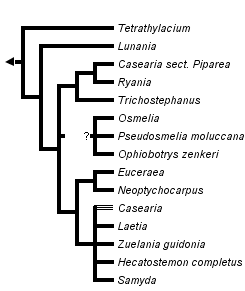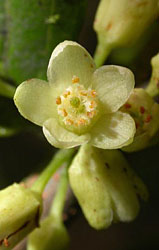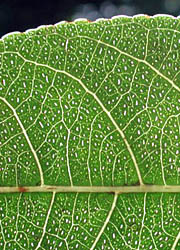Samydaceae
Mac H. Alford


This tree diagram shows the relationships between several groups of organisms.
The root of the current tree connects the organisms featured in this tree to their containing group and the rest of the Tree of Life. The basal branching point in the tree represents the ancestor of the other groups in the tree. This ancestor diversified over time into several descendent subgroups, which are represented as internal nodes and terminal taxa to the right.

You can click on the root to travel down the Tree of Life all the way to the root of all Life, and you can click on the names of descendent subgroups to travel up the Tree of Life all the way to individual species.
For more information on ToL tree formatting, please see Interpreting the Tree or Classification. To learn more about phylogenetic trees, please visit our Phylogenetic Biology pages.
close boxIntroduction
Samydaceae are a family of flowering plants formerly placed in the polyphyletic Flacourtiaceae. Samydaceae have sometimes been segregated from Flacourtiaceae (e.g., by Bentham and Hooker) as the group with well-developed hypanthia, and this tradition has been maintained in many African floras. Recent analyses based on both morphological and molecular data indicate that Samydaceae are a monophyletic and monothetic group related to Salicaceae, which now also include many former Flacourtiaceae. Some authors (e.g., Chase et al., 2002) even place Samydaceae in a broader Salicaceae. However, Samydaceae share many symplesiomorphies with other Malpighialean families, such as Passifloraceae, and show few obvious morphological connections to Salicaceae.
Like many other closely-related taxa in the Malpighiales, Samydaceae have introrse anther dehiscence, parietal placentation, and arillate seeds. They also have synapomorphies which are useful for field identification: pellucid-punctations and/or -lines (usually in the leaves) and deciduous leaf teeth (theoid type). Almost all members of the family have minute flowers. The largest genus in the family is Casearia, which has more than 180 species, and the number of species coupled with the size of the flowers has left the family largely unstudied.
The genus Casearia is pantropical, Osmelia and Pseudosmelia are from Indo-Malesia, Ophiobotrys and Trichostephanus are from tropical Africa, and all of the other genera are neotropical.
Characteristics
Shrubs or trees. Leaves alternate, pinnately veined, rarely acrodromous (Lunania), infrequently entire but more commonly with deciduous conical teeth (theoid teeth), rarely with spinose margins (Casearia sect. Casearia unranked group Ilicifoliae), rarely with stellate pubescence (Ryania), lamina often with pellucid-punctations or -lines, stipulate or exstipulate. Mostly hermaphroditic, infrequently dioecious (Euceraea, Neoptychocarpus, Osmelia, Pseudosmelia?), rarely monoecious (Trichostephanus) or polygamous (Ophiobotrys). Inflorescences usually axillary fascicles/glomerules or reduced to single axillary flowers, less commonly corymbs, racemes of spikes, or panicles of spikes. Flowers often minute, wider than 2 cm only in Ryania and Samyda. Hypanthium generally present, sometimes reduced or lacking. Sepals 4-7, possible less in Lunania but hard to tell due to early splitting, imbricate. Petals absent. Disk usually present, adnate to the calyx, and alternating with or inside the whorl of stamens, in some genera (e.g., Casearia) appearing like staminodes or a fleshy corona. Stamens 4 to numerous, typically inserted in 1-3 whorls, sometimes connate to various degrees, anther dehiscence introrse or rarely latrorse (Lunania). Gynoecium of one pistil, ovary superior, unilocular, placentation parietal, ovules few to numerous, styles usually 1 or distally 3(-5)-branched, 3 in Osmelia and Pseudosmelia, stigma usually capitate, rarely sessile. Fruits fleshy or dry 3-valved capsules, occasionally indehiscent. Seeds arillate (except Tetrathylacium) or with long, cottony hairs (Casearia sect. Gossypiospermum).
References
Alford, M. H. 2005. Systematic studies in Flacourtiaceae. Dissertation. Cornell University, Ithaca, New York, USA. 290 pp.
Bernhard, A., and P. K. Endress. 1999. Androecial development and systematics in Flacourtiaceae s.l. Plant Systematics and Evolution 215: 141—155.
Chase, M. W., S. Zmarzty, M. D. Lledó, K. J. Wurdack, S. M. Swensen, and M. F. Fay. 2002. When in doubt, put it in Flacourtiaceae: a molecular phylogenetic analysis based on plastid rbcL DNA sequences. Kew Bulletin 57: 141—181.
de Wilde, W. J. J. O. 1971. The systematic position of tribe Paropsieae, in particular the genus Ancistrothyrsus, and a key to the genera of Passifloraceae. Blumea 19: 99—104.
Gilg, E. 1925. Flacourtiaceae. Pages 377—457 in Vol. 21, Die natürlichen Pflanzenfamilien, 2nd ed. (A. Engler, and K. Prantl, eds.), Berlin.
Grill, I. 1990. Beiträge zur Karyosystematik der Flacourtiaceae. Dissertation. Universität Wien, Vienna, Austria. 55 pp.
Hallé, N., and J. J. F. E. de Wilde. 1978. Trichostephanus acuminatus Gilg (Flacourtiacées), une approche biosystématique. Adansonia, ser. 2, 18: 167—182.
Judd, W. S. 1997. The Flacourtiaceae in the southeastern United States. Harvard Papers in Botany 10:65-79.
Keating, R. C. 1973. Pollen morphology and relationships of the Flacourtiaceae. Annals of the Missouri Botanical Garden 60: 273—305.
Keating, R. C. 1975. Trends of specialization in pollen of Flacourtiaceae with comparative observations of Cochlospermaceae and Bixaceae. Grana 15: 29—49.
Kiger, R. W. 1972. The genus Samyda (Flacourtiaceae). Dissertation. University of Maryland, College Park, Maryland. 266 pp.
Kiger, R. W. 1984. Exclusions from Samyda Jacq. (Flacourtiaceae). Taxon 33: 445—468.
Lemke, D. E. 1988. A synopsis of Flacourtiaceae. Aliso 12: 29—43.
Miller, R. B. 1968. Systematic wood anatomy of the American Casearia Jacq. (Flacourtiaceae). M.S. Thesis. University of Wisconsin, Madison. 56 pp.
Miller, R. B. 1975. Systematic anatomy of the xylem and comments on the relationships of Flacourticeae. Journal of the Arnold Arboretum 56: 20—102.
Sleumer, H. O. 1954. Flacourtiaceae. Pages 1—106 in Flora Malesiana, Series 1 (C. G. G. J. van Steenis, ed.) Noordhoff-Kilff N.V., Djakarta.
Sleumer, H. O. 1980. Flacourtiaceae. Flora Neotropica 22: 1—499.
Spencer, K. C., and D. S. Seigler. 1985. Cyanogenic glycosides and the systematics of the Flacourtiaceae. Biochemical Systematics and Ecology 13: 421—431.
van Heel, W. A. 1979. Flowers and fruits in Flacourtiaceae. IV. Hydnocarpus spp., Kiggelaria africana L., Casearia spp., Berberidopsis corallina Hook.f. Blumea 25: 513—529.
Warburg, O. 1894. Flacourtiaceae. Pages 1—56 in Vol. 3(6a), Die natürlichen Pflanzenfamilien, 1st ed. (A. Engler, and K. Prantl, eds.). Wilhelm Englemann, Leipzig.
Information on the Internet
- PlantSystematics.Org. Electronic key to all taxa formerly placed in Flacourtiaceae, including all Samydaceae treated here.
- Royal Botanic Gardens, Kew. Electronic keys to most taxa formerly placed in Flacourtiaceae, including all Samydaceae treated here.
Title Illustrations

| Scientific Name | Casearia arborea |
|---|---|
| Location | Costa Rica: Heredia: Estacion Biologica La Selva |
| Copyright | © 2004 |
About This Page
Mac H. Alford

University of Southern Mississippi, Hattiesburg, Mississippi, USA
Correspondence regarding this page should be directed to Mac H. Alford at
Page copyright © 2007 Mac H. Alford
 Page: Tree of Life
Samydaceae.
Authored by
Mac H. Alford.
The TEXT of this page is licensed under the
Creative Commons Attribution-NonCommercial License - Version 3.0. Note that images and other media
featured on this page are each governed by their own license, and they may or may not be available
for reuse. Click on an image or a media link to access the media data window, which provides the
relevant licensing information. For the general terms and conditions of ToL material reuse and
redistribution, please see the Tree of Life Copyright
Policies.
Page: Tree of Life
Samydaceae.
Authored by
Mac H. Alford.
The TEXT of this page is licensed under the
Creative Commons Attribution-NonCommercial License - Version 3.0. Note that images and other media
featured on this page are each governed by their own license, and they may or may not be available
for reuse. Click on an image or a media link to access the media data window, which provides the
relevant licensing information. For the general terms and conditions of ToL material reuse and
redistribution, please see the Tree of Life Copyright
Policies.
- First online 06 February 2007
- Content changed 06 February 2007
Citing this page:
Alford, Mac H. 2007. Samydaceae. Version 06 February 2007 (under construction). http://tolweb.org/Samydaceae/68361/2007.02.06 in The Tree of Life Web Project, http://tolweb.org/











 Go to quick links
Go to quick search
Go to navigation for this section of the ToL site
Go to detailed links for the ToL site
Go to quick links
Go to quick search
Go to navigation for this section of the ToL site
Go to detailed links for the ToL site